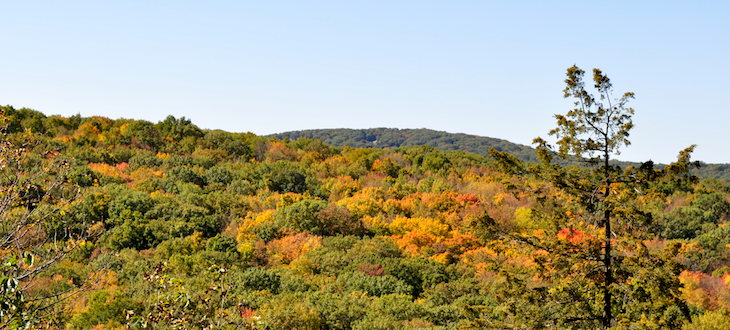The State We're In
New Jersey forests age like fine wine
Many things improve with age, like wines, cheeses, friendships, antiques and leather boots. How about forests?
It turns out that new research shows aging mature forests improve too. They are better at storing carbon and are more resilient to climate change than young forests. They also protect native animal and plant species that need large tracts of unbroken canopy.
How old is an old forest? It depends on who you ask. Timber managers call older trees “over-mature,” seldom letting trees live more than a century, since their goal is to generate wood products. On the other hand, forest ecologists would say that 150-year-old trees in the Highlands of New Jersey are only middle-aged, since these native hardwoods can live for hundreds of years.
Today, New Jersey has only a few acres of truly old-growth forests left. But many forests in this state we’re in are once again dominated by huge aging canopy trees approaching the 150-year mark!
Colonists arriving in the New World found vast primeval forests filled with centuries-old trees. But it wasn’t long before nearly all of New Jersey’s virgin forests were cleared for timber, firewood, charcoal for iron and glass furnaces, and agriculture. Photos and surveys of New Jersey landscapes from after the Civil War reveal hillside thickets, pastures, and fields, with few forests in sight.
Since that time iron, glass, and charcoal production ceased and New Jersey became less agricultural. Today forests have recovered on about 45 percent of New Jersey, or 2.1 million acres. The most special forests include hundreds of thousands of regenerated, unfragmented, core forest acres that constitute New Jersey’s state parks, forest, and wildlife management areas, as well as some large county parks and non-profit preserves.
In addition to their beauty and ecosystem benefits like flood control and water purification, these maturing forests are increasingly valuable allies in efforts to mitigate the impacts of climate change.
Here are some of the new findings on the value of older mature forests:
- A new study by the University of Vermont found that older forests in eastern North America are better able than young forests to handle projected increases in temperature and precipitation as our climate changes. Older forests are more structurally complex, the study said, with trees growing at multiple heights and larger canopy gaps, which free up growing space and increasing light availability for a mix of species.
- A study in the journal Nature found that trees don’t stop growing once they reach maturity. They do stop getting taller but, like bodybuilders, they add girth and root mass as they age. According to the study, this indicates that old forests are highly effective in pulling carbon dioxide out of the air and storing it as carbon in their wood.
- Another study, published this summer in the journal Frontiers in Forests and Global Change, found that “pro-forestation” – allowing our maturing forests to grow unfettered – will sequester more carbon far faster than the expensive and labor intensive efforts of reforesting logged areas or converting agricultural lands back to forests of young trees. Pro-forestation only requires protective designations and stewardship for those maturing forests most suited to return to old growth.
Forest restoration and replanting will help slow down the warming of our planet and keep it to 1.5 degrees above pre-industrial levels. Using pro-forestation to protect them from development and logging can have even more immediate improvements in storing carbon.
If you don’t want to wait hundreds of years to see old growth forests you can take a trip to see a rare New Jersey primeval forest that was spared the ax. They’re fantastic places to get a glimpse of what the first settlers experienced when they set foot in New Jersey.
Here are a few:
Saddler’s Woods, 25 acres in Haddon Township, Camden County, is still here today because Joshua Saddler, a former slave, forbade his heirs in the 1800s from cutting the woods for timber, according to the Saddler’s Woods Conservation Association. The forest consists of oak, beech and other species.
Mettler’s Woods, a 65-acre section of old-growth forest within the 500-acre Hutcheson Memorial Forest in Franklin Township, Somerset County, was acquired from the local Lenape tribe by Dutch settlers in 1701 and retained by their descendants. The woods were never cut and the ground never tilled. White oak trees in Mettler’s Woods average over 235 years old … and some have lived as long as 350 years.
Other old-growth forests include Tillman Ravine in Stokes State Forest in Sussex County, 25 acres of hemlock and hardwood trees; the Kuser Natural Area of High Point State Park in Sussex County, the highest elevation swamp of its kind in the world; the Bear Swamp area of the Glades Wildlife Refuge in Cumberland County; the Great Cedar Swamp, part of the Cape May National Wildlife Refuge; and the Laurel Pond area of Wawayanda State Park in Passaic County.
For more information about old forests and their benefits, go to https://www.americanforests.org/big-trees/the-importance-of-big-old-trees/.
And to learn more about preserving New Jersey’s land and natural resources, visit the New Jersey Conservation Foundation website at www.njconservation.org or contact me at info@njconservation.org.
About the Authors
Alison Mitchell
Co-Executive Director
John S. Watson, Jr.
Co-Executive Director
Tom Gilbert
Co-Executive Director, 2022-2023
Michele S. Byers
Executive Director, 1999-2021
View their full bios here.
Filter
Get The Latest News
From The Garden State
In the
News

